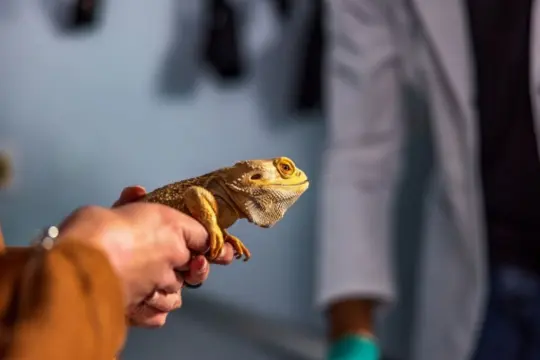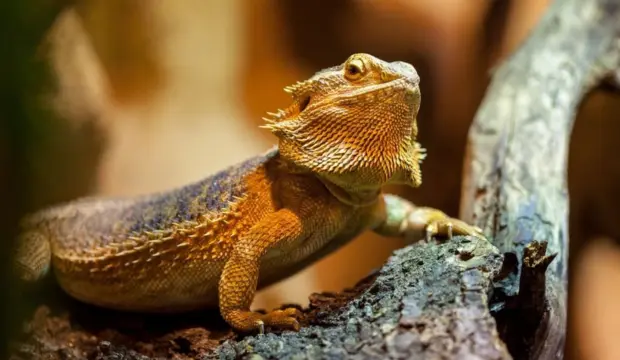Symptoms of a dying bearded dragon include abnormal movement, lethargy, loss of appetite, breathing difficulties, inflammation, muscle tremors, stool problems, wrinkled skin, and swelling.
To learn how to identify a dying bearded dragon and what steps you need to take in such a circumstance, continue reading the article.
Symptoms of a Dying Bearded Dragon
Here are some common symptoms that may indicate a dying bearded dragon:
- No bowel movements: If your bearded dragon is not having regular bowel movements, it could be a sign of illness.
- Lethargy: If your dragon is barely moving or moving less than usual, it may be seriously ill. This could be due to improper heat or lighting, which affects their metabolism.
- Lack of appetite: A dying bearded dragon may refuse to eat or show a significant decrease in appetite.
- Movement issues: Difficulty moving or a decrease in mobility can be a sign of illness or distress.
- Respiratory problems: Signs of respiratory issues include discharge from the nostrils or eyes, breathing through an open mouth, or gasping for air.
- Abnormal skin: Dull, grey, or wrinkled skin that is not part of the normal shedding process may indicate a health problem.
- Sunken or droopy eyes: Dehydration or illness can cause the eyes to appear sunken or droopy.
- Shallow breathing: If your bearded dragon is breathing rapidly or struggling to breathe, it could be a sign of distress.
- Spending more time in the cooler area: If your dragon is avoiding the warmer areas of its tank, it may be a sign of illness or discomfort.
It’s important to note that these symptoms can also be signs of other illnesses, so it’s crucial to consult a veterinarian for a proper diagnosis and treatment. If you notice multiple symptoms or have a heightened reason for concern, seeking veterinary advice is recommended.
Diagnosis and Treatment

Diagnosis and treatment for bearded dragons can involve a variety of procedures and tests. Here are some steps that can be taken:
Diagnosis:
- Physical examination: A veterinarian will perform a physical examination to check for any visible signs of illness or injury.
- Blood testing: Blood tests can help identify any abnormalities in the bearded dragon’s blood, such as low calcium levels.
- Radiographs (X-rays): Radiographs can help identify any bone abnormalities, such as fractures or signs of metabolic bone disease.
- Ultrasound examination: An ultrasound can be helpful in identifying internal abnormalities, such as tumors.
Signs of illness in bearded dragons may include sneezing, discharge from the eyes or nose, bubbles from the mouth or nose, rapid or shallow breathing, open-mouthed breathing, decreased appetite, lethargy, jaw or hind limb swelling, anorexia, depression, and lethargy
Treatment:
- Follow your veterinarian’s treatment plan: Depending on the diagnosis, treatment may involve medication, surgery, or changes to the bearded dragon’s diet or environment.
- Provide supportive care: This may include keeping the bearded dragon warm and hydrated and providing a comfortable and stress-free environment.
- Follow-up appointments: Regular check-ups with a veterinarian may be necessary to monitor the bearded dragon’s progress and adjust the treatment plan as needed.
It’s important to find a veterinarian who specializes in reptiles, known as a herp vet, for the best care of your bearded dragon. Any change from normal is cause for concern and should be immediately evaluated by your veterinarian.
Preventative Measures

Here are some preventative measures for bearded dragons based on the search results:
- Clean the enclosure regularly: Replace the bedding or substrate, or clean the surface every 1-2 days to prevent exposure to waste.
- Monitor weight: One of the most reliable ways to keep track of a bearded dragon’s health is by weighing them on a weekly basis and writing them down.
- Provide a suitable habitat: It’s important to replicate a bearded dragon’s natural habitat as best as possible. They need a vivarium that ranges from a hotter (38 to 42°C) bright end to a cooler (22 to 26°C) shaded end. You’ll also need to provide a 10 to 12 percent fluorescent UV tube at the hot end to prevent metabolic bone disease. It’s also essential to keep humidity low.
- Practice good hygiene: Keep your bearded dragon’s environment and your own personal hygiene practices in mind when handling it, such as washing your hands thoroughly.
By following these preventative measures, you can help keep your bearded dragon healthy and happy.
When to Seek Emergency Care
Bearded dragons are popular pets, but it can be difficult to tell when they are sick. Here are some signs that your bearded dragon may need emergency care:
- Weakness or lethargy: Sick bearded dragons may seem weak or grumpy, and they may hide and/or stop basking.
- Shaking, dizziness, head tilting, and loss of balance: These are also red flags that your bearded dragon may be sick.
- Wheezing, gasping, or coughing: Healthy bearded dragons should breathe quietly and smoothly. If your beardie seems to be having trouble breathing, there may be something going on with it.
- Discharge from the eyes, ears, nose, or mouth: This can be an indication of sickness.
- Rapid weight changes: If your bearded dragon is looking thin or even bony, it may be time to call your vet.
- Puffy, bulging, or swollen eyes: If your bearded dragon isn’t opening its eyes or if they seem puffy, bulging, or swollen, it could be a sign of sickness.
If you notice any of these symptoms, it’s important to seek veterinary care for your bearded dragon.
You should contact your local vet clinic to find out the exact cost of a check-up for your bearded dragon.
It’s also a good idea to schedule an appointment with an exotic pet vet when you first bring home a new bearded dragon, and to bring your pet in for an annual exam, including fecal and blood work.
Conclusion
Knowing the signs of a dying bearded dragon is crucial for pet owners. This article helps identify these signs and provides informative insights into caring for your reptile. Signs include lethargy, loss of appetite, difficulty breathing, and sunken eyes. It’s essential to seek immediate veterinary attention if any of these symptoms are present.
Additionally, proper nutrition and the environment are critical to prevention. Understanding the care requirements involved in owning a bearded dragon can prevent illness and ensure a happy, healthy pet.
